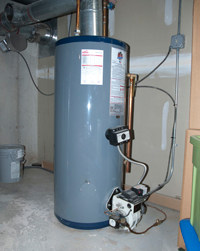How do you actually feel on the subject of How to Maintain Your Water Heater & Prolong its Life?

Warm water is important for everyday comfort, whether it's for a rejuvenating shower or cleaning recipes. To guarantee your warm water system runs efficiently and lasts longer, routine upkeep is key. This short article supplies sensible tips and insights on how to preserve your home's warm water system to prevent disruptions and expensive repair services.
Introduction
Preserving your home's warm water system could appear overwhelming, but with a few easy steps, you can ensure it operates smoothly for years to come. This guide covers everything from understanding your hot water system to DIY maintenance ideas and recognizing when to contact professional help.
Importance of Keeping Your Warm Water System
Regular maintenance not just expands the lifespan of your warm water system yet also guarantees it operates effectively. Ignoring maintenance can lead to decreased effectiveness, greater energy expenses, and also premature failing of the system.
Indications Your Hot Water System Needs Upkeep
Recognizing when your warm water system requires interest can protect against significant concerns. Look out for signs such as irregular water temperature, unusual noises from the heater, or rustic water.
Flushing the Hot Water Heater
Flushing your water heater eliminates sediment accumulation, improving efficiency and prolonging its life.
Checking and Replacing Anode Rods
Anode rods stop deterioration inside the storage tank. Examining and replacing them when worn is essential.
Facility Concerns Requiring Professional Aid
Instances include significant leaks, electric issues, or if your water heater is regularly underperforming.
Regular Specialist Maintenance Benefits
Specialist maintenance can consist of thorough examinations, tune-ups, and making sure compliance with security standards.
Checking and Adjusting Temperature Level Settings
Readjusting the temperature setups guarantees optimum performance and security.
DIY Tips for Upkeep
You can carry out numerous maintenance jobs on your own to maintain your warm water system in top condition.
Looking for Leaks
On a regular basis inspect pipelines and links for leakages, as these can bring about water damages and greater costs.
Comprehending Your Warm Water System
Before diving into upkeep tasks, it's practical to understand the basic parts of your warm water system. Typically, this consists of the water heater itself, pipes, anode poles, and temperature level controls.
Month-to-month Maintenance Tasks
Normal monthly checks can assist catch small concerns before they intensify.
Evaluating Pressure Relief Valves
Testing the stress relief valve guarantees it operates correctly and protects against extreme stress accumulation.
Insulating Pipelines
Shielding warm water pipes decreases warm loss and can save power.
When to Call an Expert
While do it yourself upkeep is advantageous, some issues need expert knowledge.
Verdict
Routine upkeep of your home's warm water system is essential for efficiency, durability, and expense savings. By complying with these tips and understanding when to seek professional help, you can ensure a dependable supply of hot water without unforeseen disturbances.
How to Maintain an Instant Hot Water Heater
- Before tinkering with your hot water heater, make sure that it’s not powered on. You also have to turn off the main circuit breaker and shut off the main gas line to prevent accidents. Also turn off the water valves connected to your unit to prevent water from flowing into and out of the appliance.
- 2. When you’re done, you have to detach the purge valves’ caps. These look like the letter “T” and are situated on either side of the water valves. Doing so will release any pressure that has accumulated inside the valves while at the same time avoid hot water from shooting out and burning your skin.
- 3. When the purge valves’ caps are removed, you have to connect your hosing lines to the valves. Your unit should have come with three hoses but if it didn’t, you can purchase these things from any hardware or home repair shops. You can also get them from retail stores that sell water heating systems. Read the user’s manual and follow it to complete this task properly. When the hosing lines are connected, open the purge port’s valves.
- 4. You should never use harsh chemical cleaners or solutions when cleaning your unit. Make use of white vinegar instead. It should be undiluted and you’ll probably use about 2 gallons.
- 5. Now flush your water heater. This task should probably take about 40 minutes. We can’t give you specific directions for this because the procedure is carried out depending on the type, model and brand of your heater. With that being said, refer to the user’s manual.
- 6. When you’re done draining the unit, you have to turn off the purge port valves again. Remove the hosing lines that you earlier installed on each of the water valves. Put the valve caps (purge port) back in their respective places and be very careful so as not to damage the rubber discs that are found inside these caps.
- 7. Now that everything’s back in place, check your user’s manual again to find out how to reactivate your water heating system.
- 8. Once it is working, turn one of your hot water faucets on just to let air pass through the heater’s water supply pipes. Leave the tap on until water flows smoothly out of it.
https://www.orrplumbing.com/blog/2014/september/how-to-maintain-an-instant-hot-water-heater/

As a person who reads on Tips For Maintaining Your Hot Water Heater, I imagined sharing that piece of content was beneficial. Enjoyed reading our review? Please share it. Let somebody else locate it. Thank-you for going through it.
Detail
Comments on “How to Properly Maintain Your Home's Hot Water SystemProfessional Tips for Caring for Your Home's Hot Water SystemHow to Extend the Lifespan of Your Home's Hot Water System By Maintenance”